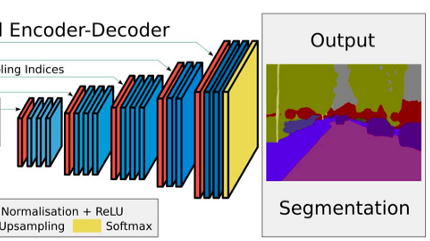模型输入必须来自“tf.keras.Input”...,它们不能是先前非输入层的输出
我正在使用Python 3.7.7。和张量流 2.1.0。
我有一个预训练的 U-Net 网络,我想获取它的编码器和解码器。
如下图所示:

您可以看到卷积编码器-解码器架构。我想要获取编码器部分,即出现在图像左侧的图层:

以及解码器部分:

我从这个函数中得到了 U-Net 模型:
def get_unet_uncompiled(img_shape = (200,200,1)):
inputs = Input(shape=img_shape)
conv1 = Conv2D(64, (5, 5), activation='relu', padding='same', data_format="channels_last", name='conv1_1')(inputs)
conv1 = Conv2D(64, (5, 5), activation='relu', padding='same', data_format="channels_last", name='conv1_2')(conv1)
pool1 = MaxPooling2D(pool_size=(2, 2), data_format="channels_last", name='pool1')(conv1)
conv2 = Conv2D(96, (3, 3), activation='relu', padding='same', data_format="channels_last", name='conv2_1')(pool1)
conv2 = Conv2D(96, (3, 3), activation='relu', padding='same', data_format="channels_last", name='conv2_2')(conv2)
pool2 = MaxPooling2D(pool_size=(2, 2), data_format="channels_last", name='pool2')(conv2)
conv3 = Conv2D(128, (3, 3), activation='relu', padding='same', data_format="channels_last", name='conv3_1')(pool2)
conv3 = Conv2D(128, (3, 3), activation='relu', padding='same', data_format="channels_last", name='conv3_2')(conv3)
pool3 = MaxPooling2D(pool_size=(2, 2), data_format="channels_last", name='pool3')(conv3)
conv4 = Conv2D(256, (3, 3), activation='relu', padding='same', data_format="channels_last", name='conv4_1')(pool3)
conv4 = Conv2D(256, (4, 4), activation='relu', padding='same', data_format="channels_last", name='conv4_2')(conv4)
pool4 = MaxPooling2D(pool_size=(2, 2), data_format="channels_last", name='pool4')(conv4)
 POPMUISE
POPMUISE1回答
-

繁星淼淼
我的建议是定义编码器和解码器的结构(get_encoder,get_decoder)。在整个模型的训练之后,我们的想法是创建一个新的解码器架构(通过get_decoder),我们可以用解码器训练的权重来填充它pythonic 来说你可以用这种方式做到这一点......def get_crop_shape(target, refer): # width, the 3rd dimension cw = (target.get_shape()[2] - refer.get_shape()[2]) assert (cw >= 0) if cw % 2 != 0: cw1, cw2 = cw // 2, cw // 2 + 1 else: cw1, cw2 = cw // 2, cw // 2 # height, the 2nd dimension ch = (target.get_shape()[1] - refer.get_shape()[1]) assert (ch >= 0) if ch % 2 != 0: ch1, ch2 = ch // 2, ch // 2 + 1 else: ch1, ch2 = ch // 2, ch // 2 return (ch1, ch2), (cw1, cw2)def get_encoder(img_shape): inp = Input(shape=img_shape) conv1 = Conv2D(64, (5, 5), activation='relu', padding='same', data_format="channels_last", name='conv1_1')(inp) conv1 = Conv2D(64, (5, 5), activation='relu', padding='same', data_format="channels_last", name='conv1_2')(conv1) pool1 = MaxPooling2D(pool_size=(2, 2), data_format="channels_last", name='pool1')(conv1) conv2 = Conv2D(96, (3, 3), activation='relu', padding='same', data_format="channels_last", name='conv2_1')(pool1) conv2 = Conv2D(96, (3, 3), activation='relu', padding='same', data_format="channels_last", name='conv2_2')(conv2) pool2 = MaxPooling2D(pool_size=(2, 2), data_format="channels_last", name='pool2')(conv2) conv3 = Conv2D(128, (3, 3), activation='relu', padding='same', data_format="channels_last", name='conv3_1')(pool2) conv3 = Conv2D(128, (3, 3), activation='relu', padding='same', data_format="channels_last", name='conv3_2')(conv3) pool3 = MaxPooling2D(pool_size=(2, 2), data_format="channels_last", name='pool3')(conv3) conv4 = Conv2D(256, (3, 3), activation='relu', padding='same', data_format="channels_last", name='conv4_1')(pool3) conv4 = Conv2D(256, (4, 4), activation='relu', padding='same', data_format="channels_last", name='conv4_2')(conv4) pool4 = MaxPooling2D(pool_size=(2, 2), data_format="channels_last", name='pool4')(conv4) conv5 = Conv2D(512, (3, 3), activation='relu', padding='same', data_format="channels_last", name='conv5_1')(pool4) conv5 = Conv2D(512, (3, 3), activation='relu', padding='same', data_format="channels_last", name='conv5_2')(conv5) return conv5,conv4,conv3,conv2,conv1,inpdef get_decoder(convs): conv5,conv4,conv3,conv2,conv1,inputs = convs up_conv5 = UpSampling2D(size=(2, 2), data_format="channels_last", name='up_conv5')(conv5) ch, cw = get_crop_shape(conv4, up_conv5) crop_conv4 = Cropping2D(cropping=(ch, cw), data_format="channels_last", name='crop_conv4')(conv4) up6 = concatenate([up_conv5, crop_conv4]) conv6 = Conv2D(256, (3, 3), activation='relu', padding='same', data_format="channels_last", name='conv6_1')(up6) conv6 = Conv2D(256, (3, 3), activation='relu', padding='same', data_format="channels_last", name='conv6_2')(conv6) up_conv6 = UpSampling2D(size=(2, 2), data_format="channels_last", name='up_conv6')(conv6) ch, cw = get_crop_shape(conv3, up_conv6) crop_conv3 = Cropping2D(cropping=(ch, cw), data_format="channels_last", name='crop_conv3')(conv3) up7 = concatenate([up_conv6, crop_conv3]) conv7 = Conv2D(128, (3, 3), activation='relu', padding='same', data_format="channels_last", name='conv7_1')(up7) conv7 = Conv2D(128, (3, 3), activation='relu', padding='same', data_format="channels_last", name='conv7_2')(conv7) up_conv7 = UpSampling2D(size=(2, 2), data_format="channels_last", name='up_conv7')(conv7) ch, cw = get_crop_shape(conv2, up_conv7) crop_conv2 = Cropping2D(cropping=(ch, cw), data_format="channels_last", name='crop_conv2')(conv2) up8 = concatenate([up_conv7, crop_conv2]) conv8 = Conv2D(96, (3, 3), activation='relu', padding='same', data_format="channels_last", name='conv8_1')(up8) conv8 = Conv2D(96, (3, 3), activation='relu', padding='same', data_format="channels_last", name='conv8_2')(conv8) up_conv8 = UpSampling2D(size=(2, 2), data_format="channels_last", name='up_conv8')(conv8) ch, cw = get_crop_shape(conv1, up_conv8) crop_conv1 = Cropping2D(cropping=(ch, cw), data_format="channels_last", name='crop_conv1')(conv1) up9 = concatenate([up_conv8, crop_conv1]) conv9 = Conv2D(64, (3, 3), activation='relu', padding='same', data_format="channels_last", name='conv9_1')(up9) conv9 = Conv2D(64, (3, 3), activation='relu', padding='same', data_format="channels_last", name='conv9_2')(conv9) ch, cw = get_crop_shape(inputs, conv9) conv9 = ZeroPadding2D(padding=(ch, cw), data_format="channels_last", name='conv9_3')(conv9) conv10 = Conv2D(1, (1, 1), activation='sigmoid', data_format="channels_last", name='conv10_1')(conv9) return conv10 def get_unet(img_shape = (200,200,1)): enc = get_encoder(img_shape) dec = get_decoder(enc) model = Model(inputs=enc[-1], outputs=dec) return model创建整个模型并拟合img_shape = (200,200,1)old_model = get_unet(img_shape)# old_model.compile(...)# old_model.fit(...)一如既往地提取编码器# extract encoderfirst_encoder_layer = 0last_encoder_layer = 14encoder_output_layer = [14, 11, 8, 5, 2, 0]encoder = Model(inputs=old_model.layers[first_encoder_layer].input, outputs=[old_model.layers[l].output for l in encoder_output_layer], name='encoder')encoder.summary()创建解码器结构并分配训练后的权重# extract decoder fitted weightsrestored_w = []for w in old_model.layers[last_encoder_layer + 1:]: restored_w.extend(w.get_weights()) # reconstruct decoder architecture setting the fitted weightsnew_inp = [Input(l.shape[1:]) for l in get_encoder(img_shape)]new_dec = get_decoder(new_inp)decoder = Model(new_inp, new_dec)decoder.set_weights(restored_w)decoder.summary()返回预测# generate random imagesn_images = 20X = np.random.uniform(0,1, (n_images,200,200,1)).astype('float32')# get encoder predictions pred_encoder = encoder.predict(X)print([p.shape for p in pred_encoder])# get decoder predictionspred_decoder = decoder.predict(pred_encoder)print(pred_decoder.shape)
 随时随地看视频慕课网APP
随时随地看视频慕课网APP
相关分类

 Python
Python